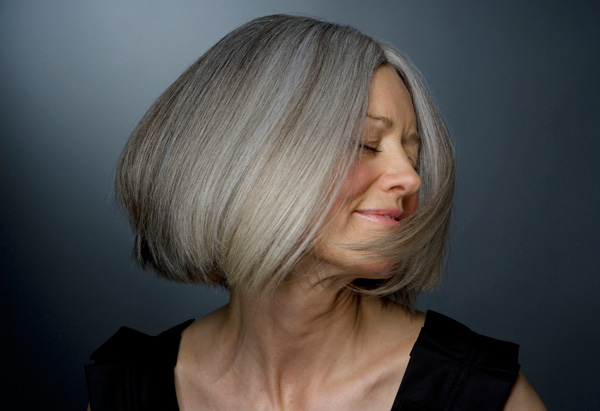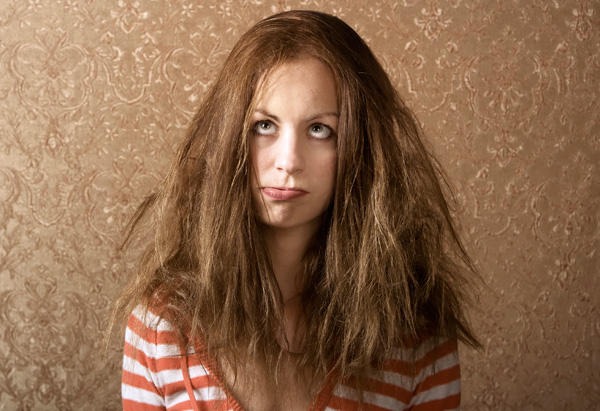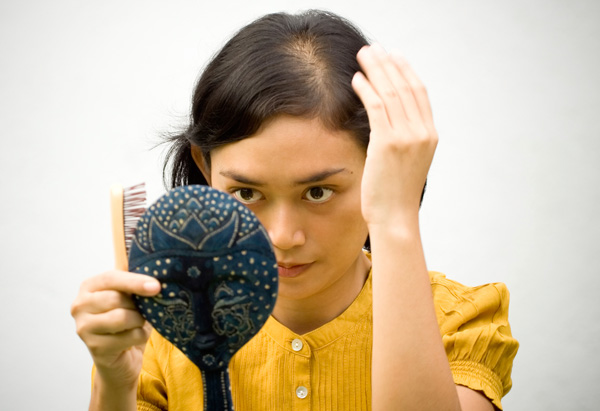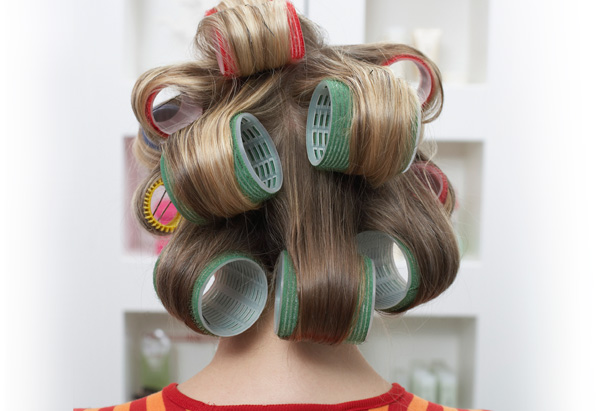When we asked you on Facebook to share your biggest hair issues, you responded—in minutes! Here, solutions for the most common ones.

Photo: Thinkstock
"I'm Going Gray!"
You have three options to do away with gray (all involving dye, of course).
When you notice only a few grays, a vegetable dye is enough to conceal them. This low-peroxide color stains gray hair so it's just a little lighter than your natural color—"which gives the effect of beautiful highlights," says New York City stylist Lisa Chiccine. The color fades (so no roots) over about 12 weeks.
When you start getting large streaks of gray, you'll need to move up to a semipermanent color. It blends gray with your natural color and shampoos out in eight to ten weeks. Semipermanent dye doesn't contain enough peroxide to lighten much, but you can match your natural color or go darker.
When you're about 30 percent gray, you'll probably want to upgrade to a permanent dye. It contains the highest level of peroxide, which you'll need to color larger areas. Permanent haircolor doesn't shampoo away; you'll likely have noticeable roots in about four weeks. If you add highlights around your temples and part, the regrowth will be less noticeable, says Chiccine. You can also try TouchBack ($30; touchbackgray.com), a temporary-haircolor marker, to extend your time between dyeing.
Ever wondered why your gray looks coarser and feels more wiry than the rest of your hair? You're not alone. No one knows. Cosmetic chemist Mort Westman of Westman Associates in Oak Brook, Illinois, has a theory, though: Because grays are missing the melanin that gives hair color, they don't absorb light and emit shine the way pigmented hair does. Without melanin, they're also more vulnerable to hair-dulling UV damage. The solution: a silicone-based styling product that adds shine and protects against UV rays. (Try John Frieda Frizz Ease Finishing Creme, $6; drugstores.) And if you have just a couple of grays, pluck them. (Forget the three-will-grow-back warning—it's bogus.)
Feeling like a renegade? Learn how to play up your gray at oprah.com/grayhair.
Next: Our step-by-step guide to taming frizz first thing in the morning

Photo: Thinkstock
I'm Frazzled By Frizz !
The best offense is a good defense. Your game plan:
8 A.M. In the shower, use shampoo and conditioner that contain rich moisturizers, like silicones, panthenol, and shea butter, to help seal the hair's cuticle (outer layer) so it won't absorb moisture in the air (the genesis of frizz). Avoid products that contain volumizing ingredients like wheat, rice, and silk proteins.
8:15 A.M. After showering, wrap your hair in a towel and lightly press it with your palms to help it absorb water—rubbing your hair dry can disturb the cuticle, leading to frizz. Then use a wide-toothed comb to detangle, says Ted Gibson, a hairstylist in New York City.
8:20 A.M. While hair is still damp, apply a generous amount (enough to cover your hair from roots to ends) of a creamy leave-in conditioner; the heavy emollients in the formula prevent frizz. (Try Garnier Fructis Style Sleek & Shine Intensely Smooth Leave-In Conditioning Cream, $6; drugstores.)
8:30 A.M. Once your hair has air-dried about 50 percent, use a large round brush to blow it out, aiming the nozzle of the hair dryer downward.
8:45 A.M. If things are still looking a little fuzzy, rub a small dollop of the same leave-in conditioner you applied to your damp hair between your palms; run it over your dry hair from roots to ends. For coarse and curly hair, spring for a serum instead, and smooth a dime-sized dollop from midlength to ends. The moisturizers in the leave-in conditioner could weigh down your curls if applied to dry hair; the silicones in most serums tend to be more lightweight.
Next: Is your hair thinning? You're not alone

Photo: Thinkstock
"I'm Losing It!"
Thinning hair can be devastating. But we have calming news.
You're not alone. Up to 60 percent of women experience hair loss at some point. The causes are multiple—genetics, hormones (too much thyroid, not enough thyroid, low estrogen, high androgen), or trauma (an allergic reaction, high fever, stress). The most common, and chronic, cause is a genetic condition called androgenetic alopecia.
Help has arrived. If your hair loss was triggered by a specific event (like a reaction to a new medication), it will grow back once that issue is addressed. If it's chronic, there are two FDA-approved treatments available. Minoxidil (brand name Rogaine) comes in 2 percent and 5 percent over-the-counter formulas; applied topically twice a day, it can help stop thinning and (in about 40 percent of women) regrow some hair. If you're postmenopausal, your doctor can prescribe finasteride (brand names Propecia and Proscar), an oral medication that stops the production of one of the androgens that can exacerbate hair loss (most doctors won't prescribe it to women in their childbearing years because it could cause birth defects in a male fetus). Some doctors also use lasers to help treat hair loss, but there are no large independent studies proving their efficacy. If you'd consider surgery, you could be a candidate for a hair transplant, which can now create natural-looking results in women.
The future looks bright. Two areas of research that are particularly promising:
1. The drug company Allergan is currently seeking FDA approval for a topical hair-loss treatment containing bimatoprost, the active ingredient in the eyelash-growing drug Latisse. Clinical trials are under way, and doctors estimate that a treatment could be available in 2014.
2. Researchers have already shown—in mice—that it is possible to use stem cells to grow new hair. "Within the next ten years, that technology could be a reality for humans," says Michael Longaker, MD, codirector of Stanford School of Medicine Institute for Stem Cell Biology and Regenerative Medicine. Stem cells would be removed from an area where you have dense hair growth, then injected into thinning areas to stimulate new growth.
The Truth About Hair Growth Supplements
"I have never seen a study that proves vitamin supplements work to make hair grow longer or thicker," says Jerry Shapiro, MD, an adjunct professor of dermatology at New York University whose practice specializes in treating hair loss. If you're losing hair, supplements can help stop or slow the shedding—but only if you have a deficiency in certain vitamins. Shapiro suggests supplements for patients whose blood tests show that they are low in vitamin D, zinc, or iron. He doesn't even test, however, for deficiency in biotin—the vitamin most commonly found in supplements marketed to help hair growth. "If you were truly biotin deficient—which is extremely rare in this country—you would be too sick to make it into my office."
Illusions of Thickness
Hair loss treatments can take up to a year to work. In the meantime, the right hairstyle will camouflage thinning. Keep your cut above shoulder length—if your hair is too long, it will look wispy, says New York City hairstylist Sam Brocato. Blunt ends make hair look thicker, so skip layers. When hair is thinning at the crown but still thick in front, bangs give a fuller look. And readers on oprah.com rave about two products for concealing thinning hair: Toppik ($22; toppik.com), a shake-on powder made of tiny keratin fibers that cling to your existing hair to fill in sparse patches, and Joan Rivers Beauty Great Hair Day ($30; qvc.com), a pressed powder that helps eliminate the shine from exposed scalp (and camouflages roots, too). If you've lost all or most of your hair (for whatever reason—chemo, genetics, an autoimmune disease like alopecia areata), you might want to consider a wig. The good and bad news: You have hundreds of options. Go to oprah.com/wigs for help sorting through them.
Next: Does your hair fall flat—no matter what you do?

Photo: Thinkstock
"No Matter What I Do, My Hair Goes Limp!!"
Dozens of you swore to us that your flat, lifeless hair could never hold a style. We empathize, but we know that with the right routine and products, it can. Here's how.
» Oil makes hair limp, so it's important to minimize the sebum on your scalp, says hairstylist Rodney Cutler, owner of the Cutler salons. Use a shampoo that contains astringents like rosemary and orange extracts or tea tree oil, wash your hair daily, and skip conditioner. If the ends of your hair are dry, use a little bit of volumizing conditioner on them.
» While hair is still damp, spritz a volumizing spray at your roots, then flip your hair upside down and blow-dry. (We like Matrix Total Results Amplify Wonder Boost Root Lifter, $15; matrix.com for salons.)
» Want some wave or curl? Apply a spray gel (like Redken Spray Starch 15 Versatile Ironing Spray, $14; redken.com for salons) on dry hair from midlength to ends, comb it through, then use a one-and-a-half-inch curling iron to create waves in two-inch sections; the gel gives your hair the grip it needs to hold the curls. Finish with a strong-hold aerosol hairspray. Use it liberally—the latest formulas (like Tigi Catwalk Session Series Finishing Hairspray, $21; catwalkbytigi.com) don't get sticky or crunchy.
» To maintain your style all day, spray a dry shampoo on your roots to absorb oil and create volume; keep a travel-sized bottle (like Oscar Blandi Pronto Invisible Volumizing Dry Shampoo To Go, $11; sephora.com) in your bag.
More Beauty Fixes




